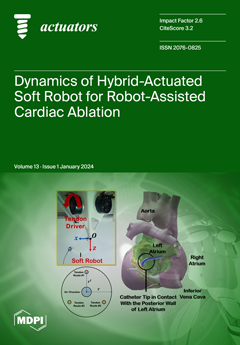Lower limb exoskeleton rehabilitation robots have become an important direction for development in today’s society. These robots can provide support and power to assist patients in walking and movement. In order to achieve better interaction between humans and machines and achieve the goal of flexible driving, this paper addresses the shortcomings of traditional elastic actuators and designs a series elastic–damping actuator (SEDA). The SEDA combines elastic and damping components in parallel, and the feasibility of the design and material selection is demonstrated through finite element static analysis. By modeling the dynamics of the SEDA, using the Bode plot and Nyquist plot, open-loop and closed-loop frequency domain comparisons and analyses were carried out, respectively, to verify the effect of damping coefficients on the stability of the system, and the stiffness coefficient
ks = 25.48 N/mm was selected as the elastic element and the damping coefficient
cs = 1 Ns/mm was selected as the damping element. A particle swarm optimization (PSO)-based algorithm was proposed to introduce the fuzzy controller into the PID control system, and five parameters, namely the the fuzzy controller’s fuzzy factor (
ke,
kec) and de-fuzzy factor (
kp1,
ki1,
kd1), are taken as the object of the algorithm optimization to obtain the optimal fuzzy controller parameters of
ke = 0.8,
kec = 0.2,
kp1 = 0.5,
ki1 = 8,
kd1 = −0.1. The joint torque output with and without external interference is simulated, and the simulation model is established in the MATLAB/Simulink environment The results show that when fuzzy PID control is used, the amount of overshooting in the system is 14.6%, and the regulation time is 0.66 s. This has the following advantages: small overshooting amount, short rise time, fast response speed, short regulation time, good stability performance, and strong anti-interference ability. The SEDA design structure and control method breaks through limitations of the traditional series elastic actuator (SEA) such as its lack of flexibility and stability, which is very helpful to improve the output effect of flexible joints.
Full article





